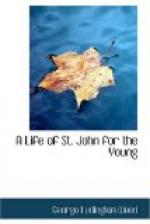And the three themselves—what were their emotions as they looked down upon their companions in the plain below, and upward to the height whither their Master was bringing them. Did they whisper together concerning the word He had just spoken—that He must die. They must have had such mingling of feelings as they never had before.
It was the evening after a Sabbath. At the close of the weary summer day, after the long and steep ascent of the mountain, and in the strong mountain air, it is no wonder that the three disciples were “weighted with sleep.”
Luke not only tells us that Jesus went up “to pray” but also that “He prayed.” Would that John had recorded that prayer, as he did those supplications in the Upper Room and in Gethsemane. “As we understand it,” says Edersheim, “the prayer with them had ceased, or merged into silent prayer of each, or Jesus now prayed alone and apart.”
On the banks of the Jordan, where Jesus and the three had met, while He “was praying, the heavens were opened,” and the dove-like form descended upon Him, and His Father’s voice was heard. And now “as He prayed,” there came an answer, immediate and glorious: “He was transfigured before them.”
The disciples though “weighted with sleep,” “having remained awake, they saw His glory, and the two men that stood with Him.” It was many years after this vision that John, speaking for the three, testified, “We saw His glory.”
“The fashion of His countenance was altered.” “His face did shine as the sun.” “His garments became exceeding white; so as no fuller on earth can whiten them,” “white as the light,” “glistering,” “dazzling.”
“Behold there appeared unto them Moses and Elijah talking with Him.” How did the disciples know the Lawgiver and the Prophet? We are not told. There may have been given them some supernatural powers of discernment. They may have known by the conversation between Jesus and His celestial visitants, as, in earthly language with heavenly tone, they “spoke of His departure which He was about to accomplish at Jerusalem,” of which He had told them on the plain below.
It was that Moses who fifteen hundred years before came down from Mount Sinai with the two tables of the law in his hands, when Aaron and the children of Israel stood in awe before His shining face. But now He had come, not from the mount which Paul describes as “darkness,” but unto that other whose snowy whiteness has given it the name of Lebanon. He had come from Heaven, to yield homage to Him to whom He would sing with us,
“My dear Redeemer and
my Lord,
I read my
duty in Thy Word;
But in Thy life the
Law appears,
Drawn out
in living Characters.”
“The children of Israel could not look steadfastly upon Moses for the glory of His face.” In the “excellent glory” by which Peter describes the scene on Hermon, the whole figure of His Lord was bathed in light. But the glory of that vision was not yet complete. A cloud, brighter than any on which the moon was shining, enwrapped Jesus and Moses and Elijah. It was no other than the Shechinah, once more returning to the earth,—“the symbol of Jehovah’s presence.”




